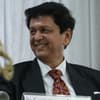Podcast
Questions and Answers
What is the initial step a researcher should take when beginning a research process?
What is the initial step a researcher should take when beginning a research process?
- Prepare the research design.
- Conduct an extensive literature survey.
- Develop a working hypothesis.
- Formulate the research problem. (correct)
What is the primary purpose of conducting an extensive literature survey in the research process?
What is the primary purpose of conducting an extensive literature survey in the research process?
- To write a thesis for a Ph.D. degree.
- To create a list of all previous research projects.
- To understand the existing research on the problem under investigation. (correct)
- To finalize the research design.
What is the primary function of a working hypothesis in the research process?
What is the primary function of a working hypothesis in the research process?
- To summarize all previous research.
- To determine the final project outcome and analysis.
- To act as a tentative assumption that guides the research. (correct)
- To provide a definitive conclusion to the study.
Why should the working hypothesis be specific and limited?
Why should the working hypothesis be specific and limited?
What does preparing the research design involve?
What does preparing the research design involve?
Which of the following is NOT a typical source used during an extensive literature survey?
Which of the following is NOT a typical source used during an extensive literature survey?
When formulating the research problem, what are the two key steps involved, according to the provided content?
When formulating the research problem, what are the two key steps involved, according to the provided content?
Why is it important to state the research problem in clear terms, before beginning to write a research design?
Why is it important to state the research problem in clear terms, before beginning to write a research design?
Which of the following best describes the primary goal of a research design?
Which of the following best describes the primary goal of a research design?
When is a flexible research design most appropriate?
When is a flexible research design most appropriate?
What is the researcher's main task after data collection?
What is the researcher's main task after data collection?
What does the process of 'interpretation' in research involve?
What does the process of 'interpretation' in research involve?
What is the primary purpose of including a 'Summary of Findings' section in a research report?
What is the primary purpose of including a 'Summary of Findings' section in a research report?
What should be included in the 'Introduction' section of a research report?
What should be included in the 'Introduction' section of a research report?
What is the key feature of the writing style recommended for research reports?
What is the key feature of the writing style recommended for research reports?
In what order should the main text of a research report generally be presented?
In what order should the main text of a research report generally be presented?
Which of these are key elements to be included in the end matter of a research report?
Which of these are key elements to be included in the end matter of a research report?
What is the main purpose of 'hypothesis testing' in the research process?
What is the main purpose of 'hypothesis testing' in the research process?
Flashcards
Research Process
Research Process
A series of steps necessary for conducting research effectively.
Research Problem
Research Problem
The specific issue or area of interest to study.
Formulating Research Problem
Formulating Research Problem
Identifying and clearly stating the research issue.
Literature Survey
Literature Survey
Signup and view all the flashcards
Working Hypothesis
Working Hypothesis
Signup and view all the flashcards
Research Design
Research Design
Signup and view all the flashcards
Hypotheses Testing
Hypotheses Testing
Signup and view all the flashcards
Approval of Synopsis
Approval of Synopsis
Signup and view all the flashcards
Research Purposes
Research Purposes
Signup and view all the flashcards
Exploration Purpose
Exploration Purpose
Signup and view all the flashcards
Description Purpose
Description Purpose
Signup and view all the flashcards
Execution of the Project
Execution of the Project
Signup and view all the flashcards
Data Analysis
Data Analysis
Signup and view all the flashcards
Generalization
Generalization
Signup and view all the flashcards
Report Preparation
Report Preparation
Signup and view all the flashcards
Appendices and Bibliography
Appendices and Bibliography
Signup and view all the flashcards
Study Notes
Research Process Steps
-
Formulating the Research Problem:
- Researcher identifies a particular area of interest.
- The initial problem statement may be broad, refined by addressing ambiguities.
- Feasibility of a solution is evaluated before formulating a working problem statement.
- Key steps involve thorough comprehension and rephrasing for an analytical viewpoint.
-
Extensive Literature Survey:
- A concise summary of the problem is written.
- Required for research theses (e.g., Ph.D.).
- Submitted to a committee or board for approval.
- Involves a detailed review of relevant research materials (journals, books, reports, bibliographies).
-
Developing Working Hypotheses:
- Clear statement of working hypotheses after literature review.
- Hypotheses are tentative assumptions used to draw and test logical/empirical conclusions.
- Provide focus for research.
- Direct the design of data analysis and influence data quality.
- Hypotheses must be specific & limited to the current research.
-
Preparing the Research Design:
- A structured plan to conduct the research efficiently and effectively.
- Aims to gather relevant evidence with minimal resources (time, money, effort).
- Research purpose guides design: exploration (flexible design), description (minimizing bias, maximizing reliability), diagnosis, experimentation.
-
Executing the Project:
- Crucial step impacting data quality and dependability.
- Execution must be systematic and timely.
-
Analyzing Data:
- Involves organizing, categorizing, and statistically interpreting data.
- Using coding, tabulation, and statistical inference methods.
-
Hypothesis Testing:
- Evaluate hypotheses based on analyzed data.
- Determine if facts support or contradict the hypotheses.
-
Generalizations and Interpretation:
- Drawing conclusions based on repeated support for a hypothesis may lead to a theory.
- If no hypothesis exists, findings are interpreted in relation to a theory.
- Interpretation may lead to further research questions.
-
Preparing the Report/Thesis:
- Structure: preliminary pages (title, date, acknowledgements, foreword), main text (introduction, summary of findings, main report, conclusion), end matter (appendices, bibliography, index).
- Writing style: concise, objective, simple language, avoid vague expressions.
- Use visuals (charts, illustrations) only if they enhance clarity.
Studying That Suits You
Use AI to generate personalized quizzes and flashcards to suit your learning preferences.





